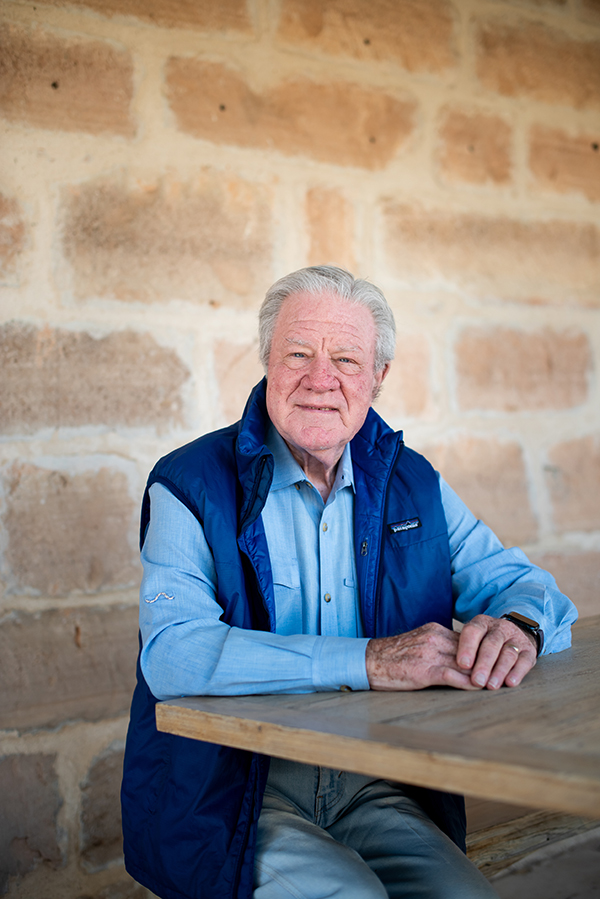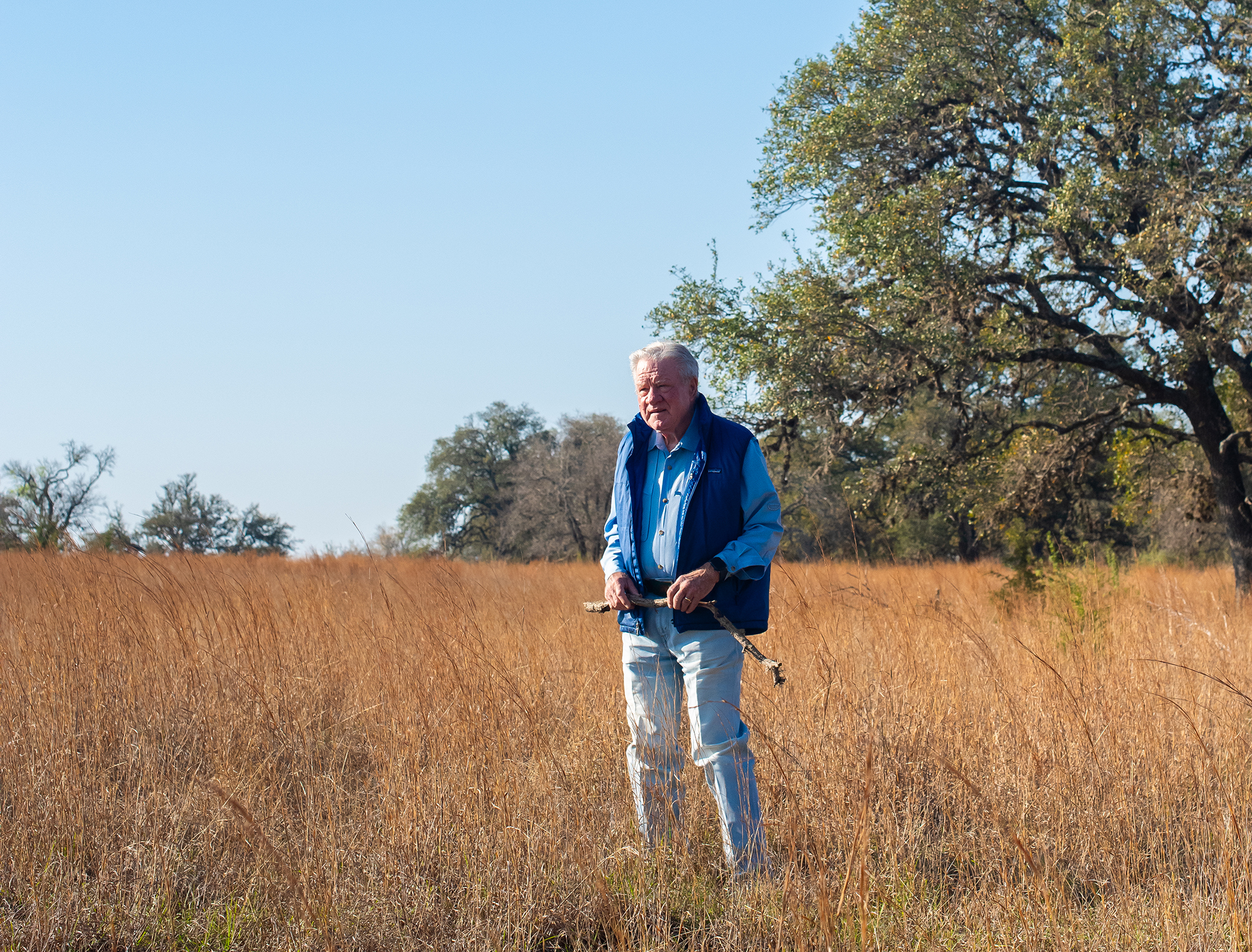From atop a high hill on the Hershey Ranch, Andy Sansom points out landmarks discussed earlier at the stone house. Gusty March gales threaten to upend us as we watch an approaching storm front turn the day from mild to extra spicy. Falling silent, we puzzle over an unusual cloud formation just above the northern horizon, spewing out spirals of white foam as if from a smashed toothpaste tube. That’s no cloud, that’s wildfire smoke.

Looking somewhat like a cowboy-cut Moses overlooking the promised land, Sansom quickly gauges the distance to the fire and the wind direction. “We’re not in the path,” he assures me, and calmly resumes my tour of Gillespie County’s largest conserved property, the 1,565-acre Hershey Ranch. We keep a watchful eye on the Crabapple Fire that afternoon (it lasted a week and burned 10,000 acres), but the famed 79-year-old conservationist, who has spent decades triaging problems without panic, is unperturbed.
Maybe that’s because Sansom is a force of nature himself, making an unforgettable impact on the state’s crucial public lands by creating common ground between unlikely allies. These days, he’s laser-focused on the Hill Country and this ranch. Coming full circle, he’s putting those decades of “preaching” into practice on a precious parcel entrusted to him by conservation legend Terry Hershey (with an assist from none other than Texas’ former First Lady, Lady Bird Johnson).
The whole enchilada
Already a lover of exploring the outdoors and splashing around in a creek, young Andy was introduced to the Hill Country on vacations to visit relatives. “We would come over here in the summer and swim in the Guadalupe, then go back to Houston and dream about it the rest of the year,” he recalls. “If there’s any part of our state that you could rightfully describe as ‘enchanted’ it would be the Hill Country. It’s not just the landscape. It’s the culture — it’s the whole enchilada.”
Sansom’s craving for that enchilada stuck with him through his high school years while managing the neighborhood pool, and later at Texas Tech, where he learned about conservation’s role in nature. After school, conservation took him to Washington, D.C., for a number of years to work at the national level. The native Texan returned home to head up the The Nature Conservancy in Texas, the Texas Parks and Wildlife Department, and the Meadows Center for Water and the Environment at Texas State University. Sansom’s accomplishments preserving some of the state’s most precious jewels could fill a book, and they do. A new biography by Laura Raun — Andrew Sansom: A Life in Conservation, TAMU Press — provides the details.
You could never describe Sansom as retired: still teaching, still struggling with an overstuffed inbox, still handling daily requests for advice and connections. He continues to teach at Texas State University and adds his oft-noted sparkle to the numerous banquets and conferences that beg for his presence. There’s no more popular ambassador for wild Texas than this unassuming hero, who greets everyone like a long-lost friend.
So how did this conservation icon choose a Hill Country ranch for his next chapter? Maybe it chose him.
Once owned by a Scottish cotton trader, the ranch gained its present moniker in 1976 when Lady Bird Johnson beseeched her friend Terry to acquire a property close to her home. Legend has it that when Lady Bird arrived for a hen party one afternoon, Terry greeted the burly Secret Service agents with a plate of sandwiches and a firm invitation to “go upstairs and watch TV.”
Hershey’s life later intersected with Sansom’s at Texas Parks and Wildlife, and she invited him to spend long weekends at the ranch, a peaceful space to write his books. All those decades ago, he began a quiet routine that still guides his daily life. “That first [Thursday] night I would sort of dream, conceptualize, make an outline, set a word goal,” he says. “And then the next morning I would go out and chop wood or cut the grass or something. I really enjoy just working outside.” Sansom says that manual labor helped clear his mind, and then the writing flowed.
Building a cathedral
In 2003, the beautiful two-story stone house burned completely (including Sansom’s research). Hershey, then 80, whose main residence was in Houston, wondered about the practicality of rebuilding. Her unique circle of close friends, who she lovingly called “Terry’s Rockpile Committee” and her “Rally-Around Friends” in the ranch’s copious scrapbook, provided help and guidance during construction. Sansom and his wife Nona were a part of the gang.
When all was done, Hershey and her husband donated a conservation easement on the property to the Hill Country Conservancy, and the Hershey Ranch became Sansom’s family home for life. They learned to become accustomed to the incremental progress of ranch work and inspired by the thought of working for future generations. “It’s like building a cathedral,” Sansom says. “We live in the reality that people who will really enjoy this are not yet born.”
The Sansoms, including daughter April — the CEO of Bamberger Ranch in Blanco County — make sure plenty of folks do get to enjoy the Hershey Ranch today. “We are on a pretty rigorous deer management program in partnership with Texas Parks and wildlife,” Sansom says, “and 95 percent of it is done by either women or children who we invite to come up for the first time.”
Every year, two youth hunts draw children from across the state who have never experienced the outdoors like this. “Often, they’ll come back, they’ll get their parents to apply again,” he says. Huntmaster Ryan Spencer has developed a group of families that come back every year to be the guides. After the season’s over, the guides bring their own kids out to hunt.
Biologist Romey Swanson keeps a trailer parked on the ranch, doing some biology and leading all-women hunts on the property for first-timers. “The first hunt was all women who work in conservation organizations,” Sansom says. “Those are unbelievably powerful. I’ve been down to the campfire after the weekend was over, and a lot of the women would be emotionally overwhelmed by just working with each other, accomplishing this.”
Hope for the Hill Country
While the Hershey provides plenty of challenges, Sansom feels drawn to the larger problems of the Hill Country, particularly water. “We’re all out here because of the beauty,” he says. “I still feel part of a movement to protect places like this, particularly at a time when these are among the fastest-growing counties in the United States. I’m really concerned about the Hill Country. You know in some ways what has happened out here is kind of fun and exciting. But it’s clearly not sustainable.”
Sansom says he’s disappointed in the lack of progress and inspiration by legislators and water suppliers but heartened to see the formation of a coalition of water conservation groups to work toward mutually beneficial solutions. He enjoys the view of home from the ranch road hilltop, the Milky Way in the night sky, the eagle that visits their little lake and the lack of artificial noise. He’s inspired to keep building that cathedral.
Whenever Andy speaks to a group, he’s inevitably asked about how folks can help. “Whether you’re an accountant or a school teacher, or a lawyer, or a garage owner, you can find a way in the course of a year to bring a child to the out of doors,” he tells them. “That’s the most important thing we can do for children: take them fishing, take them hunting, take them canoeing or tubing. That’s the future of this movement.”


